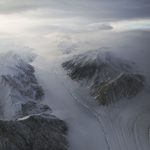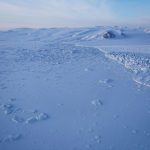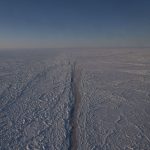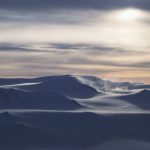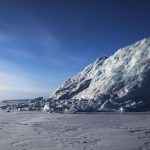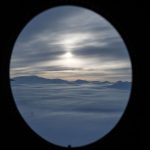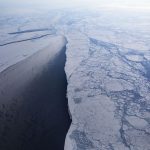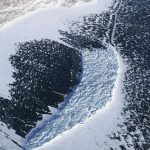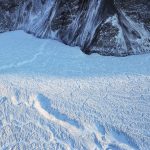Arctic ice
By Andrew Freedman
NASA’s airborne survey shows how global warming is transforming the Arctic
Nothing about the Arctic is normal right now. Rapid climate change is transforming the vast region by warming air and sea temperatures, shifting weather patterns, and melting sea and land ice at faster rates than were ever anticipated by even the most pessimistic forecasts a few years ago.
March 2017 became the sixth month in a row to set a record for the lowest sea ice extent, according to the National Snow and Ice Data Center (NSIDC). For the third straight year, Arctic sea ice peaked at a record low level during the winter season, missing a staggering 471,000 square miles of sea ice compared to the 1981-2010 average winter peak.
In other words, a chunk of ice about the size of Texas, California, and Kentucky combined was missing from the top of our planet.
One of the ways scientists are keeping tabs on sea and land ice in the Arctic and Antarctica is by flying aircraft with special instruments on board to collect high-resolution data on ice thickness and glacier movement.
In addition, photos from the aircraft taking part in the expedition, known as Operation IceBridge, provide stunning glimpses of what is at stake in the Far North as global warming rapidly reshapes the region.
From massive icebergs and broken, pancake-like sea ice to enormous fragile glaciers, the NASA aircraft are among our most important eyes on the Far North.
Such eyes are crucial for monitoring a region in transformation.
In March, Arctic sea ice also hit a record low seasonal peak for sea ice volume, which is a measure of the thickness of the ice. This record indicates that the ice cover present in the Arctic is young and thin, and therefore more susceptible to melting during the upcoming spring and summer, possibly leading to another record low sea ice extent in September.
The Arctic is warming at about twice the rate of the rest of the world, largely due to a phenomenon known as Arctic amplification. As sea ice melts, it exposes darker ocean waters beneath it to incoming solar radiation, causing the water temperatures to rise. These milder ocean waters then melt more ice while also increasing air temperatures, which in turn goes on to melt more ice and snow, exposing more darker surfaces, and so on.
The records came at the end of one of the strangest winters that Arctic climate researchers have seen in modern times. In at least four instances, unusually mild air swept across the entire Arctic from the North Atlantic or Pacific Oceans, bringing the North Pole to near or just above the melting point.
A section of an ice field on Ellesmere Island, Canada. The ice fields of Ellesmere Island are retreating due to warming temperatures.
Katabatic wind-blown snow caught behind craggy peaks, near Meehan Glacier in NW Greenland.
The C-130 flies over a long frozen-over sea ice lead.
A section of glacier flows between mountains on Ellesmere Island, Canada.
“As a scientist, I am interested in monitoring and quantifying the changes occurring in the Arctic and examining how they are interconnected and what their causes might be,” said NASA scientist Claire Parkinson. “As a person, I am concerned about the changes and the rapidity with which they are occurring.”
Until recently, it was thought that most of the sea ice loss in the Arctic was occurring from the top on down, due to warming air temperatures that melted sea ice, exposed darker ocean waters, and went on to melt more ice.
However, a study published on April 6 in the journal Science found that bottom-up ice loss is also happening, particularly in the eastern Arctic Ocean where the Atlantic Ocean is making inroads.
Consider that for a minute. The ocean that has existed at the top of the planet throughout human history is losing its characteristics to the point where at times it now more closely resembles ocean waters located far to the south.
One of the hallmarks of the eastern Arctic Ocean is an area of cold and less salty water that lies above warm, dense, and salty water drawn in from the Atlantic. The separation, or “stratification,” of ocean layers has kept those warmer waters under the surface, allowing surface waters to cool and form sea ice.
Think about stratification as a layer cake that was once clearly defined, with the layers neatly separated. Today, the Arctic Ocean is experiencing a merging of the layers.
A patch of sunlight illuminates an ice field on Ellesmere Island, Canada.
There is no reason to suggest all hope is lost in the Arctic.
Since the 1970s, the eastern Arctic Ocean has become less stratified, particularly in recent years, the Science study found. During recent winters, the cap of cold water has completely broken down, bringing warmer Atlantic waters to the surface and limiting sea ice growth.
While the changes in the Arctic have been rapid and widespread, many scientists believe there is still time to slow the pace of Arctic warming — or eventually reverse course altogether.
The Arctic serves as an alarm bell on climate change, warning the rest of the world what is about to happen elsewhere as global warming continues.
“From a personal view, I see these changes in the Arctic as a harbinger of what is to come for the rest of the planet,” said Walt Meier, a research scientist at NASA’s Goddard Space Flight Center in Maryland. “The Arctic, because much of it is on the cusp of freezing/melting, is particularly sensitive to warming. It is where global warming happens first,” he said in an email.
A March 6 study in Nature Climate Change found that if the world meets the temperature target in the Paris Climate Agreement, then the Arctic Ocean has less than a 50 percent chance of being ice-free during the summer.
More warming, though, would bring much greater odds of all the sea ice melting in the summer, causing the Arctic to be an open ocean during the season. There’s a 73 percent probability of such a scenario occurring if global warming reaches 3 degrees Celsius, or 5.4 degrees Fahrenheit, above preindustrial levels, the study said.
“We are at a critical point where decisions to slow greenhouse gas emissions … will have important effects to future Arctic climate change,” said Zack Labe, a graduate student at the University of California, Irvine, who specialized in Arctic climate change.
“Essentially, there is no reason to suggest all hope is lost in the Arctic. And there hasn’t necessarily been a tipping point,” he said. “However, it remains crucial that we focus on new alternative forms of energy and seek solutions and a better understanding of adaptation and mitigation of climate change.”
A section of an ice field is seen from the window of NASA’s Operation IceBridge research aircraft above Ellesmere Island, Canada.
IMAGES:
MARIO TAMA/GETTY
Other Images:
John Sonntag/NASA,
ZACK LABE
JEREMY HARBECK/NASA
For more on this story go to: http://mashable.com/2017/04/13/arctic-meltdown-nasa-photos-changing-ice/?utm_cid=mash-com-Tw-main-link#Pu83UU5wAPqV




